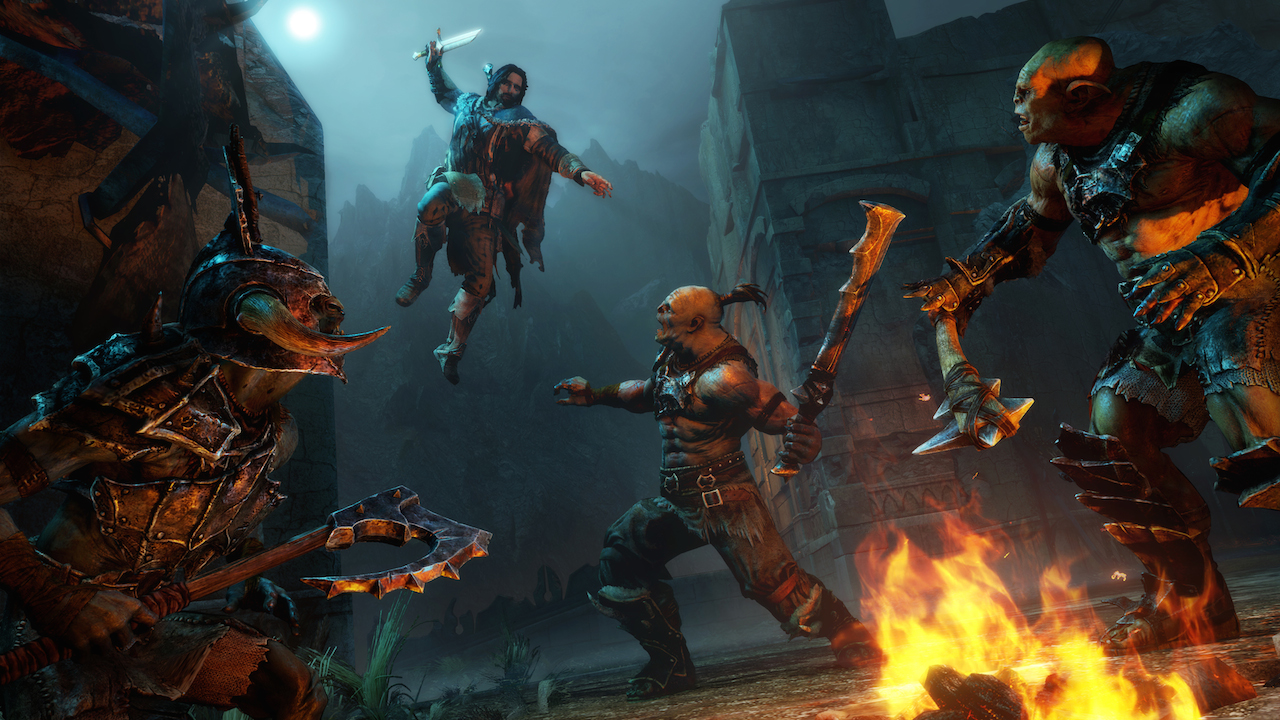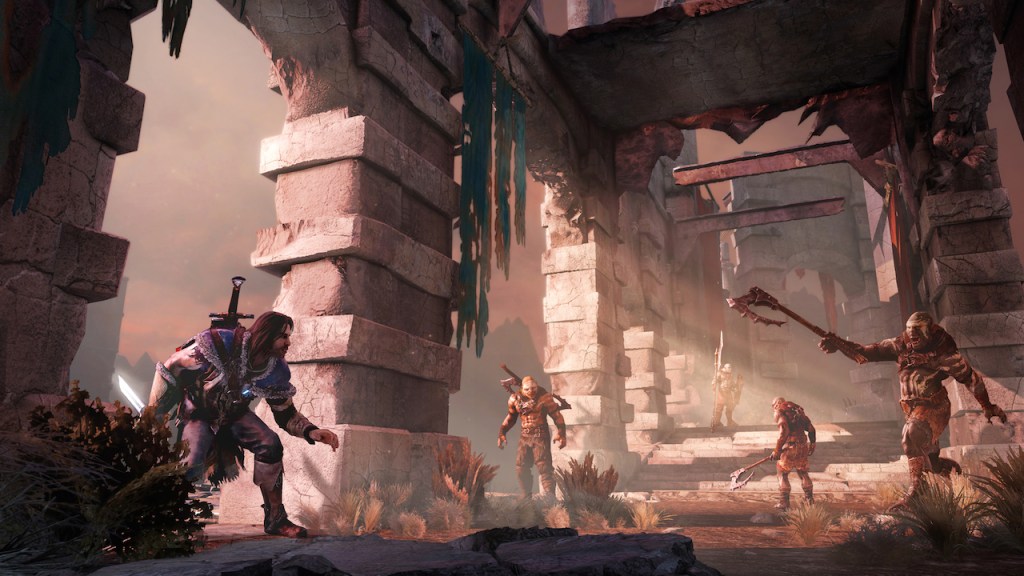One wraith to dominate them.
In the pantheon of video gaming, there isn’t much like riding around an open world without consequence of law or rule enforcement or even the recklessness of any attempt I might have at completing a Tony Hawk’s Pro Skater line in real life. So it gave me great pleasure to mount one of Middle-earth’s Caragors, bulldog-like beasts with vicious teeth capable of tearing the hide of an unlucky Uruk. Thankfully, the world presented in Middle-earth: Shadow of Mordor is littered with enemies of the orc variety.
They grow green and scaly, carry big clubs, and generally want to beat the player up for being himself a ghost of the battlefield, a lost soul with a mission seemingly determined by the total loss of his wife and child. Players take on the role of this sort of half-wraith named Talion, complete with a broken sword for silent combat and a series of ghostly special moves that ultimately elevate Shadow of Mordor beyond most brawlers. If I haven’t already protested my fondness for not finishing games, I’ll say it again while also qualifying Shadow of Mordor’s system of orc-military governance as progressive and exceedingly fun.
I couldn’t possibly continue this review without revealing that I’ve never read the original Lord of the Rings books myself and the idea that three Hobbit movies will come from one book seemed excessive. Still, the fiction remains one of the most astounding and complete universes I’ll ever come to not really understand. It’s nice that Shadow of Mordor crafts its own path between the two points of reference (as well as The Silamrillion) and lets players generally roam free in its sandbox.
Players might discover that Shadow of Mordor, when compared to something like Grand Theft Auto V, feels more like a wholly original Arkham City game as opposed to Rocksteady’s upcoming focus on the Batmobile in Arkham Knight. That doesn’t keep Talion from controlling a bit like a car when cruising around fields and climbing over encampments. Essentially, Monolith has built several set piece designs for players to run through on multiple occasions. Perhaps better yet, mission design actually encourages the player to look at every encounter in largely new ways.
I don’t much care for the game’s story which even features (a very convincing) Liam O'brien as Gollum [the original version of this review incorrectly identified the actor as Andy Serkis] and two very talented and recognizable video game voice artists, but I love fighting orcs and almost everything else about how the mechanics work on a macro and micro level. This starts relatively early as combat throws in various counters, beat-down, and finishing moves. Soon, players can brand, phantom-stun, and command entire Uruk armies if they so desire.
Players will likely have even more fun increasing their selection of upgrade-able combat moves and adding power to weapons like the elven bow and arrow, sword, aforementioned dagger, or the abilities branching off those moves. For one, focus power allows for precision aiming with the bow while shadow abilities soon give you the ability to leap across battlefields and finish an orc in a single blow. Shadow abilities also allow you to aim your bow at a beast and mount at later levels.
Where Middle-earth: Shadow of Mordor excels is in offering up multiple paths of accomplishing the same goal. In the earliest part of the game, this can feel not unlike Assassin’s Creed’s earliest missions though more high-level encounters actually play the artificial intelligence against itself where whole groups of your enemies will clash against each other in front of you. Some will be clearly labeled as duels so you can choose the outcome or let it play out on its own, though the more elaborate encounters can prove messy for anyone unwilling to face combat.
I particularly like the way enemies interact with each other and no matter where you go it seems like you’re doing a hero’s duty given that slaves litter the landscape and the Uruk have no business with them. So why not free some people while you’re climbing from building to cliffside? The map itself is divided into larger portions of land though each remains impressive in the sense that it will take players 20 minutes of even slightly distracted time to get from one end to the other. More often than not, you’ll run across a rune to pick up or even an incredible opportunity to tear into a stealth mission with precision.

For a next-generation console game (I reviewed on the PS4) the production values are fantastic and the sound design really sells a few of the rainy scenes. Still, greener pastures ensure colorful visuals even on the back of a Graug. While I still have quite a ways to level up in combat and more of the game’s story to explore, you don’t have to bend my arm to get me to play more.
As much as I like Gollum, Celebrimbor as the mysterious elven ghost that gives Talion power, and even Queen Marwen whose visions of the future spell grave times for Middle-earth, it’s too much fun to pit teams of monsters against each other. Death means nothing other than the empowerment of rival orcs, though branding several of Mordor’s uglier generals gave me a great sense of control in the kind of world that more often than not hates the player; Arkham City features too many mean thugs who threaten Batman from the rooftops and Assassin’s Creed veils so much secrecy in its playful toying with history.
Middle-earth just wants the player to explore it like a playground. You can climb up structures, leap from them to tackle a wild creature of the land, and even enlist your own group to drive the dramas that ensue. Shadow of Mordor paints the pictures that rest somewhere between bookends.
Copy provided by publisher. Review based on PlayStation 4 version. Also available for PC and Xbox One on September 30th, 2014. Available on PlayStation 3 and Xbox 360 November 18th, 2014.
-
Deep combat and traversal mechanics
-
Exceedingly varied skill tree and rune system
-
Excellent voice acting and sound design
-
Gorgeous landscapes
-
Multiple points of entry and exit of elaborate level design
-
Wandering story
-
Tons of Uruk to kill or control
-
Mission variety











